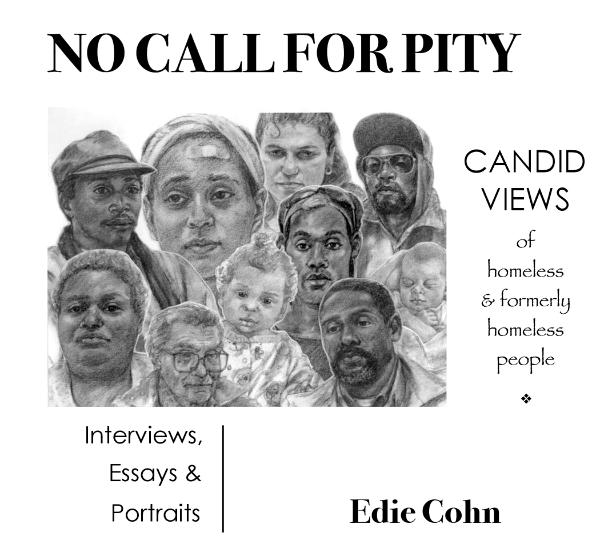 NO CALL FOR PITY
NO CALL FOR PITYThis book isn't about homelessness. It's about people
who happened to be homeless. The people whose
stories and faces are preseted here don't ask for pity.
Understanding, yes, but not pity!
Introduction
I started this project in 1991. I was an artist looking for a cause that would help others as well as my career. For three years, one day a week, I drove downtown to the Durham Community Shelter for H.O.P.E., determined to render portraits of residents that captured not only their images, but their spirits as well. At the end of each drawing session, I paid the resident five dollars. I kept the original drawings and brought the person a print of the finished portrait within the next few weeks.
Early in the project, I consented to draw a persistent young man who kept asking me, in whispered tones, to draw him. He had AIDS and wanted the portrait for his mother. I didn’t know whether or not to believe him: everybody at the shelter wanted a drawing and everybody had stories. But as I said, he was persistent. As I drew him he started telling me about his weekend. He had tried to kill himself but the medics had arrived too quickly, had saved his life and even put him up in a nice hotel afterwards. He was quite embarrassed about the whole thing. Besides, he had felt too lousy to enjoy the hotel.
Until that point I hadn’t asked questions of the people I was sketching. I just wanted to draw them for an exhibit; their lives were their own business. But if someone tells you he tried to commit suicide recently, you have to respond. So as I scrutinized this man’s face for shadows and highlights, I asked about his symptoms. He told me he didn’t have much bladder control and that he often wet his bed, something other guys at the shelter teased him about.
This man did send his picture home to his mom. I began to think about what it would be like to be dying and unable to go home to one’s family. I wondered if my own son and I would ever be in this situation. I started to wonder about other stories, whispered or left untold. I decided to expand the scope of the project so that others could hear the voices of the people I was drawing. I bought the best tape recorder I could afford and began taping stories as I drew. I also discovered my own voice through writing as I tried to make sense of the turmoil the project had unleashed in me.
I tried not to discriminate in choosing whom to draw and interview for this project. I tried not to look for the person with the most God-awful story. I didn’t want to turn the project into a soap opera about homelessness.
Most of the people I worked with were African Americans, making the project a general reflection of Durham’s homeless population. (For the record, the majority of homeless people in the United States are white.)
Primarily I drew people at the shelter, but I also drew some families at Genesis Home, a Durham facility providing transitional housing for homeless families.
To the people I met, the shelter seemed more like a temporary stopping-off point than the end of the world. Most were in transition. They had made mistakes, were trying to leave some part of the past behind, or wanted to move from their home situation and couldn’t afford anywhere else to live. Some had been victimized and were reevaluating their lives. Many were working on moving out. A few, deep in alcoholism or drug dependency, didn’t care to leave. Some had left and come back.
A recent grant from the North Carolina Humanities Council enabled me to reinter-view and redraw people from the original project. I found only a few of the sixty-five people with whom I had worked. None of the five people whose stories appear in this booklet are now homeless, and their stories may or may not be typical of the original group of participants. Two of the men pictured on the cover of this booklet have died. Others I have simply lost track of. Some leads stopped when people didn’t return my phone calls. Maybe these people weren’t doing so well and didn’t want to be reminded of it or perhaps they didn’t want the world to know about their past.
So keep in mind as you go through this booklet that, yes, there are people who have turned their lives completely around. But they may not be the norm. This is just a small sampling.
March 2002
Be the first to post a comment.